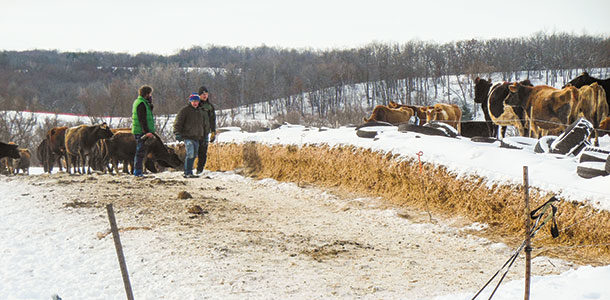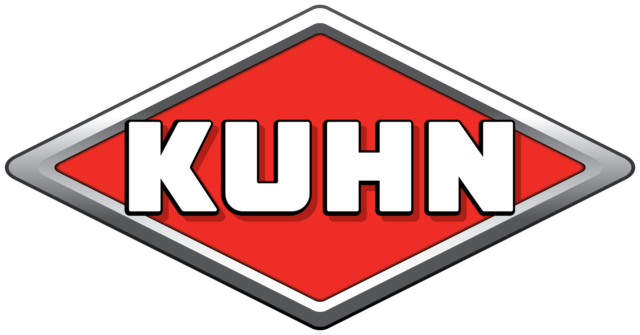Winter in Iowa can be brutal, with bitter temperatures, strong winds and lots of snow. The cows on Dan and Bonnie Beard’s farm handle the harsh season just fine even though they are housed outside all winter long. “The secret is to give them enough area that they can always find a place that is protected so they are comfortable,” Dan says.
Their farm is located in what is referred to as the “Driftless Area” of northeast Iowa, which means there are plenty of valleys, ridges and hills. The Beard farm features about 600 acres, of which 160 is dedicated strictly to the dairy cows. Many of the pastures include wooded areas the cattle have access to in harsh weather.
Other pastures are used for their herd of about 45 beef cows and their son Tom’s flock of 170 ewes and their lambs.
Their organic herd consists of 145 cows milked in a swing-16 parlor they built in 1995. They started dairy farming in 1983 with a small herd of Holsteins and a 21-stanchion barn. They started outwintering their herd when they built the parlor. They purchased two Jersey herds about that same time and were soon milking 90 cows.
They started drying up their herd for the harshest winter months in 2000. They now stop milking about the end of December, and they start freshening cows about April 1. They breed their cows initially with A.I. and then have a few bulls for cleanup. Since they are an organic herd, they do not use any synchronizing drugs to breed the cows; they sell any cows that don’t get bred during the two-month window.
“We don’t have cows with full udders when the weather is at its worst,” Bonnie adds to the reasons outwintering works on their farm.
They have a bedded pack and shelter for the cows when they calve, and the calves are housed inside for the first few weeks of life.
During silage harvest, the Beards create piles of silage in the winter pastures that are 3 to 4 feet deep. They seal it with sheets of plastic that are 150 by 50 feet. When it’s time to start feeding a pile, they put up a hot wire along the face and move it every day. “It’s high maintenance, but we need to check on the cows every day anyway,” Dan says.
A general rule of thumb is that you will need about 1 foot of silage for each cow, so a 150-foot width works well for their 140 cows.
“The silage really helps to stretch out the hay,” he says, and there is very little waste feeding the silage this way.
Last winter the snow got so deep they used their cross-country skis to go out to check on the cows.
When they gather up their harvested hay, they also place the bales according to how they will use them in the winter months. They place small groups of about five round bales of hay at various locations in the pasture. The cows get access to one group of bales at a time.
Once all the hay is cleaned up at a given location, the Beards roll the round-bale feeders to the next group of bales and move the hot wire. “You need to keep on eye on it,” Dan says. “You don’t want waste from moving it too soon, but you also don’t want them to go hungry.”
Dan says they use pigtail posts to move the wire, using a cordless drill with a masonry bit when necessary to get them into the frozen ground.
“We tend to gain a lot of fertility from the manure wherever the bales are located,” he says, so they use different areas from year to year.
The cows do tend to eat quite a bit more when it is really cold out, and the energy from the corn silage helps as well, they say. The Beards keep an eye on the cows’ body condition, but the cows generally stay in good shape since they can find shelter from the wind.
Dan says they don’t usually do a lot of stockpiling, and the pastures they do stockpile allow for earlier grazing in the spring rather than using the grasses for feed in the winter.
They do plant turnips and oats in the late summer on 10 or 11 acres. They turn the cows out on those fields in November and December, and the cows eat the turnips out of the ground.
“Turnips will keep growing until it’s about 11ºF out. It’s a small percentage of their total dry matter intake, but any fresh feed is really good for the cows,” he says.
He adds that the cows will continue to seek out the turnips even when the tops get mushy as long as the snow isn’t too deep.
The herd is rotationally grazed in the summer months on pastures that include ryegrass, orchardgrass, clover, alfalfa, reed canary and Kentucky bluegrass. They have about 60 paddocks that they rotate through about every 30 days. Most of the paddocks are about 2 or 3 acres, which is typically a meal for the herd.
The Beards say the layout of their farm is not ideal and some of the pastures are more than a mile from the buildings. When they use those far-off pastures for one of the cows’ meals of the day, they are sure to graze them near the buildings for their next meal.
When they are milking, the cows receive a TMR consisting of baleage, dry hay, corn silage when they have it and a small amount of grain they grow themselves.
Dan and Bonnie operate the farm with the assistance of their sons, Sam, Parker and Tom. Tom has his own sheep operation and grows organic crops. Parker is a full-time student at nearby Luther College and helps when he is not in class, and Sam works full-time on the farm but loves to travel whenever he gets the chance. PD
Kelli Boylen is a freelance writer in Waterville, Iowa.
PHOTO
The Beards’ farm is located in what is referred to as the “Driftless Area” of northeast Iowa, which means there are plenty of valleys, ridges and hills. Photo courtesy of the Beard family.





